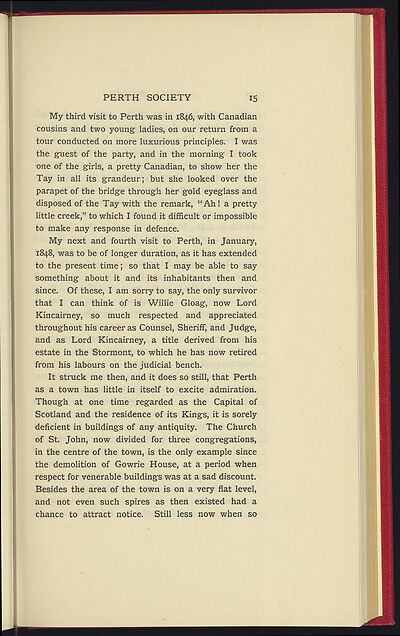Auld Perth
(33)
Download files
Complete book:
Individual page:
Thumbnail gallery: Grid view | List view

it
PERTH SOCIETY 15
My third visit to Perth was in 1846, with Canadian
cousins and two young ladies, on our return from a
tour conducted on more luxurious principles. I was
the guest of the party, and in the morning I took
one of the girls, a pretty Canadian, to show her the
Tay in all its grandeur; but she looked over the
parapet of the bridge through her gold eyeglass and
disposed of the Tay with the remark, "Ah ! a pretty
little creek," to which I found it difficult or impossible
to make any response in defence.
My next and fourth visit to Perth, in January,
1848, was to be of longer duration, as it has extended
to the present time; so that I may be able to say
something about it and its inhabitants then and
since. Of these, I am sorry to say, the only survivor
that I can think of is Willie Gloag, now Lord
Kincairney, so much respected and appreciated
throughout his career as Counsel, Sheriff, and judge,
and as Lord Kincairney, a title derived from his
estate in the Stormont, to which he has now retired
from his labours on the judicial bench.
It struck me then, and it does so still, that Perth
as a town has little in itself to excite admiration.
Though at one time regarded as the Capital of
Scotland and the residence of its Kings, it is sorely
deficient in buildings of any antiquity. The Church
of St. John, now divided for three congregations,
in the centre of the town, is the only example since
the demolition of Gowrie House, at a period when
respect for venerable buildings was at a sad discount.
Besides the area of the town is on a very flat level,
and not even such spires as then existed had a
chance to attract notice. Still less now when so
PERTH SOCIETY 15
My third visit to Perth was in 1846, with Canadian
cousins and two young ladies, on our return from a
tour conducted on more luxurious principles. I was
the guest of the party, and in the morning I took
one of the girls, a pretty Canadian, to show her the
Tay in all its grandeur; but she looked over the
parapet of the bridge through her gold eyeglass and
disposed of the Tay with the remark, "Ah ! a pretty
little creek," to which I found it difficult or impossible
to make any response in defence.
My next and fourth visit to Perth, in January,
1848, was to be of longer duration, as it has extended
to the present time; so that I may be able to say
something about it and its inhabitants then and
since. Of these, I am sorry to say, the only survivor
that I can think of is Willie Gloag, now Lord
Kincairney, so much respected and appreciated
throughout his career as Counsel, Sheriff, and judge,
and as Lord Kincairney, a title derived from his
estate in the Stormont, to which he has now retired
from his labours on the judicial bench.
It struck me then, and it does so still, that Perth
as a town has little in itself to excite admiration.
Though at one time regarded as the Capital of
Scotland and the residence of its Kings, it is sorely
deficient in buildings of any antiquity. The Church
of St. John, now divided for three congregations,
in the centre of the town, is the only example since
the demolition of Gowrie House, at a period when
respect for venerable buildings was at a sad discount.
Besides the area of the town is on a very flat level,
and not even such spires as then existed had a
chance to attract notice. Still less now when so
Set display mode to:
![]() Universal Viewer |
Universal Viewer | ![]() Mirador |
Large image | Transcription
Mirador |
Large image | Transcription
Images and transcriptions on this page, including medium image downloads, may be used under the Creative Commons Attribution 4.0 International Licence unless otherwise stated. ![]()
| Sports publications > Auld Perth > (33) |
|---|
| Permanent URL | https://digital.nls.uk/234314910 |
|---|
| Description | More than 230 sports publications from the National Library of Scotland's collections. Featured sports include football, rugby, golf, shinty, athletics, bowls, cricket and hockey. Among the material from the late 19th and early 20th centuries are match programmes, club histories, and handbooks. From the late 20th century are promotional materials to encourage greater diversity in sport. Most items cover sports activities in Scotland. There are also publications relating to the Olympics and international matches. |
|---|---|
| Additional NLS resources: |
|

